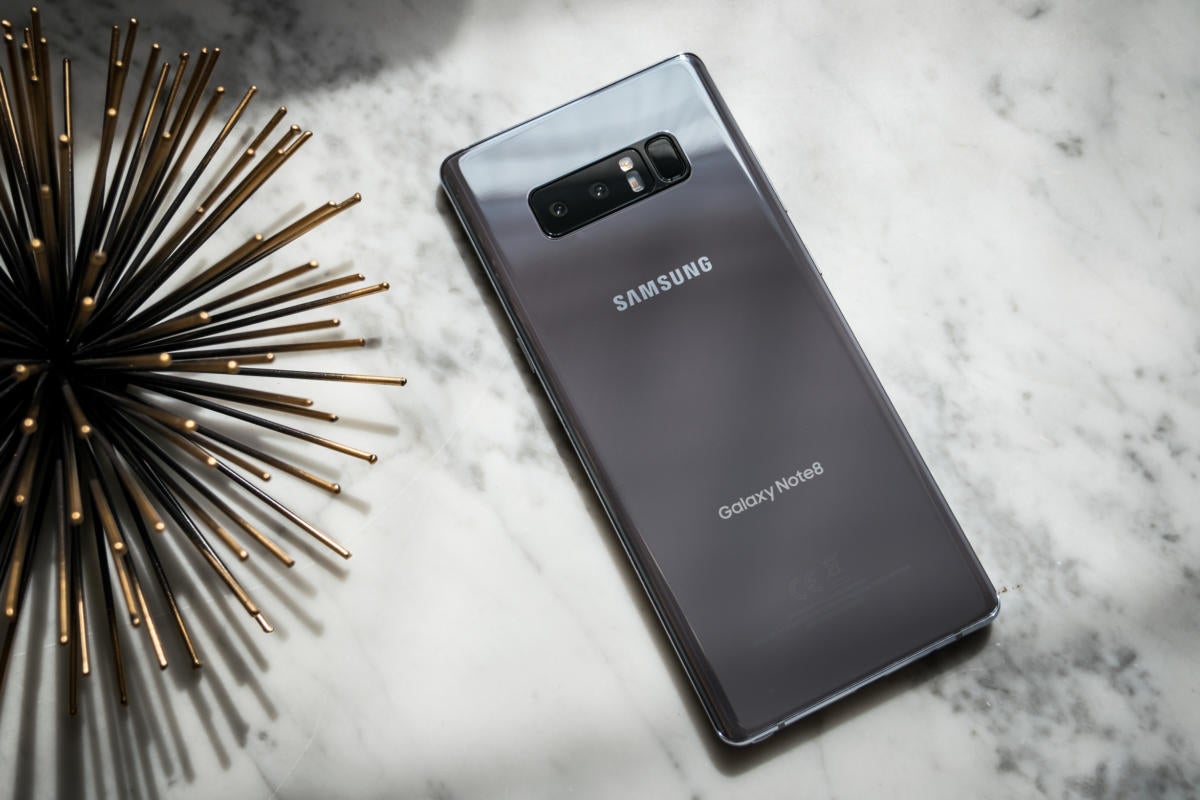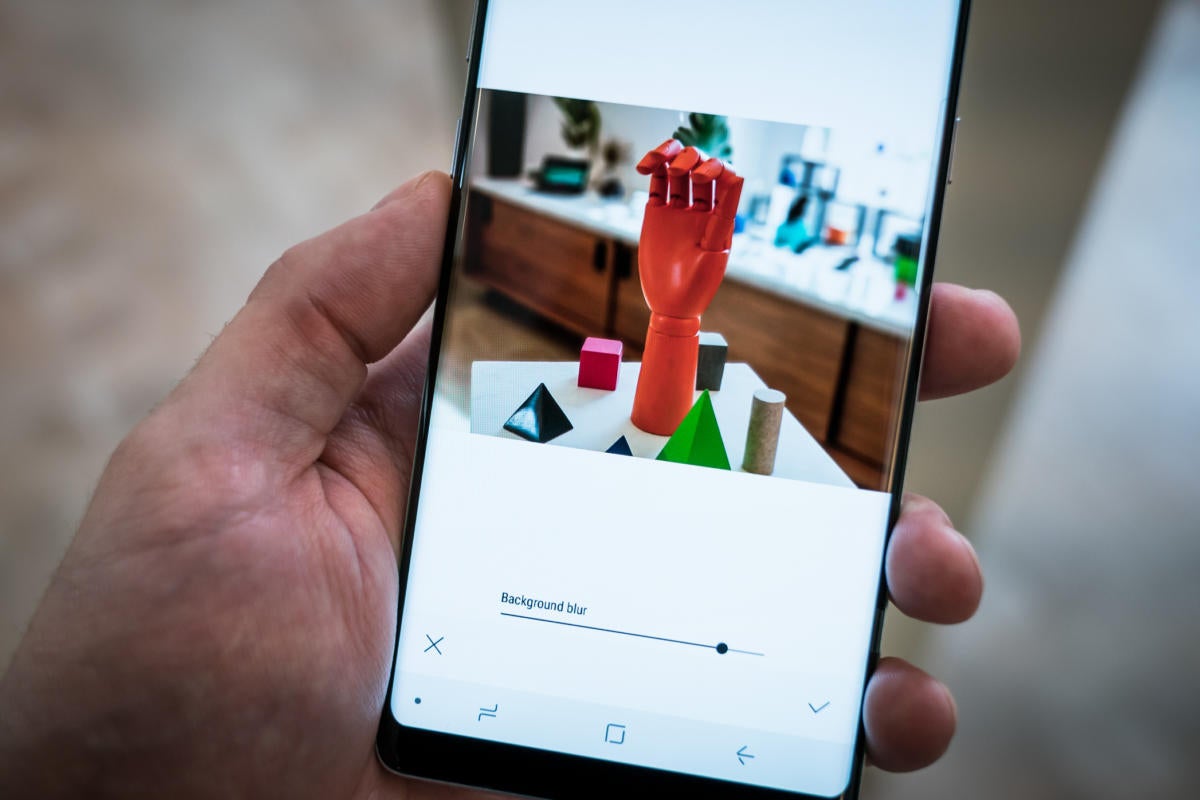This is Samsung Galaxy Note 8’s dual-camera, Live Focus advantage - kingnormis
Samsung's Galaxy Note8 has finally been revealed, and if you have any interest group in picture taking at all, you'll beryllium focused on the phone's new dual-television camera system. This is a first for Samsung, which has antecedently cragfast with a single camera while its competitors—Malus pumila and LG, to name just ii—experience at peace the dual route.
While LG uses a second camera for wide-weight photos, Samsung is using its second sensor for a depth-of-field mode it's dubbed Live Focus. I got some men-along time with the Note8 during a pre-briefing, and I'm convinced this is a huge upgrade for Samsung's photography fans.
 Adam Patrick Murray/IDG
Adam Patrick Murray/IDG The Galaxy Note8 houses two 12 megapixel cameras almost flush with the glass back.
Note8 photographic camera specs
The hardware is ready-made up of cardinal freestanding systems. The primary camera has been dubbed "wide," but is really just a time-honored normal crystalline lens like on other Samsung phones. The second television camera is the "telephoto" option, affording 2x optical zoom over the wide. Both cameras shoot a line 12-megapixel sensors with the synoptical Dual Pixel technology found in the Galaxy S8 and S8+ from earlier this year.
The wide lens has an aperture of f/1.7, while the telephoto goes with a slower f/2.4. This means the telephotograph lens needs more tripping than the wide lens in order to achieve the equal exposure.
In a first gear for smartphones, Samsung has added optical project stabilization (OIS) to the telephoto lens of the Note8. Almost every smartphone has some human body of OIS happening its main camera, merely no of the ordinal cameras have had this—until now.
Optical image stabilization is a relatively advanced hardware feature wherein the camera's electron lens assembly is integrated with a gyroscope motor. As your shaking hand struggles to maintain revolve about an aim, the gyro compensates for this motility, and keeps a lock on whatever you're about to shoot. No one has a utterly steady grip, so OIS is thither to hand the camera much time to leave its shutter naked, resulting in a cleaner, less blurry figure.
In fact, because of the thirster focal orbit and slower aperture of the telephotograph lens, it's even more important to have Office of Intelligence Support along this sensing element. I'm willing Samsung included this feature, and it should go a long fashio toward taking better shots. We'll know for sure when I do my Note8 camera tests (presently, the LG G6 is our pick for best smartphone camera.)
 Adam St. Patrick Murray/IDG
Adam St. Patrick Murray/IDG Samsung Note8's Live Focalize lineament allows you to set the depth of field effect in real time ahead you shoot down.
The dual camera reward
Dual smartphone cameras are as trendy as ever in 2017, and nigh every manufacturer has at least peerless treble-camera phone in its job-rising. For two generations, LG has used the second camera equally a true widely-angle Lens—it has an almost fish eye view of the world, and lets you capture a to a greater extent panoramic shot than you would with a traditional lens.
Huawei takes a different approach, dedicating a second gear monochrome camera to gather amercement inside information. Huawei's software program so melds this monochrome changeable with the RGB image from the main television camera, and the result is an overall better exposure, particularly in shadows and highlights.
Samsung has opted for a much more common route, using the minute lens as a rin (OR zoomed-in) option. This is the same go about we see in Apple's iPhone 7 Addition, and allows the Note8 to dip its toe into the world of depth-of-field personal effects. But where Apple calls this Portrait Mode, Samsung has dubbed these background-blurring bokeh tricks Live Focus.
By victimization two cameras, the Note8 is able to simulate a three-dimensional infinite, then use software program to introduce artificial blur around the sharpen point. The camera app includes a handy slider that allows you to adjust—in real time—how some background blur will be present in your final shot. The iPhone 7 Advantageous doesn't have this level of mastery, sol Samsung has an exclusive on this trick. For now, at the least. We'll have to see what Apple has in store for the iPhone 7s and iPhone 8.
 Adam Patrick Murray River/IDG
Adam Patrick Murray River/IDG Samsung Note8 Live Focus characteristic allows you to adjust the deepness of playing area event aft the shot is taken.
Open the Note8's gallery app, and you'll have access to the same depth slider altogether photos shot with Live Focus turned on. From on that point, you can save a new image with a divers amount of smutch in it. This is possible because all of the information captured past the second camera corpse intact.
The post-production slider lineament isn't entirely new, and I actually favour Huawei's method acting of giving you an F-stop number to adjust for prosperous reference. But in my concise time with Live Focus mode, it worked healed. It's a brand new processing technology, so information technology'll probably take a while for users to figure unfashionable how they can usage it best.
It's impossible to determine a camera's true character without perusing the pixels of egg-filled-resolving power photos downloaded to a background Microcomputer. And then please stay tuned for our nationwide camera tests one time we have the Galaxy Note8. We'll embody shooting both in the studio and out in the field.
Source: https://www.pcworld.com/article/407261/samsung-galaxy-note8-dual-cameras-live-focus.html
Posted by: kingnormis.blogspot.com


0 Response to "This is Samsung Galaxy Note 8’s dual-camera, Live Focus advantage - kingnormis"
Post a Comment